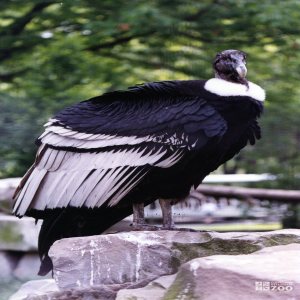Andean Condor
[Vultur gryphus]

The Andean Condor is one of the largest flying birds. The male has a wingspan of 10 feet and weighs about 26 pounds, with a length of 40 to 46 inches. The female is slightly smaller and weighs about 20 to 22 pounds. The condor's head and neck are bare because this bird feeds on carrion, and without feathers they do not run the risk of disease carried by bacteria from within the carcass. The hooked beak is designed for ripping and tearing meat. The male has a fleshy comb or crest of red or black and a white ruff at the base of the neck. The rest of the plumage is black except for a large patch of silvery gray on the wings. Wrinkled, fleshy wattles adorn the neck, and the eyes are brown. Females lack the crest and wattles, have red eyes, and are smaller in size. Young condors are a uniform brown. For both sexes the nasal septum is perforated. The legs and feet are flesh colored. The feet are suitable for walking, but not for grasping prey. Hence, condors must feed on the ground. Condors make no sound. Median life span is 70 years.
Location: Outdoor Flight Cages
Share:
Range
Their range of the Andean Condor is South America, mainly the Andean cordillera.
Habitat
The habitat of the Andean Condor is mountain peaks and shorelines. Also scrubland, grassland and desert.
Conservation Status
VulnerablePrimary Threats
Human Wildlife CoexistenceGestation
The incubation of the Andean Condor's eggs is 54 to 58 days.
Litter
Clutch: 1-2. Bluish white eggs
Behavior
The Andean Condor’s ability to soar for long periods and at great heights (up to 15,000 feet) is unsurpassed by any other species. Its sense of smell is very highly developed. Andean condors do not carry their food away, but feed on the ground. Gorged condors have been easily captured by Indians and others who know that a sated condor is unable to take off and fly. Like other vultures, condors will urinate on their legs in very hot weather. The evaporating urine cools them. They congregate in flocks until breeding season, at which time flocks disperse. In order to collect vitamin D from the sunlight the Condor needs, it spreads its wings and “sun bathes.”
Reproduction
As with all New World vultures, the Andean Condor does not build a nest. Instead, eggs are laid on the ground in tree cavities or between rocks. During November and December two whitish-yellow eggs with brown spots are laid. Condors have a very low reproductive rate, producing at most one chick every two years. The actual nest is most often in crags, often exposed to wind and bad weather. Both male and female rear the young, which fly at 6 months and are almost adult in size and weight. When mating, the male bounces up with gaping and hissing bill-snapping. Both sexes perform wing-spreading displays. Condors reach sexual maturity at 7 to 8 years.
Wild Diet
Their diet in the wild is Carrion, especially dead sea lion pups and small animals.
